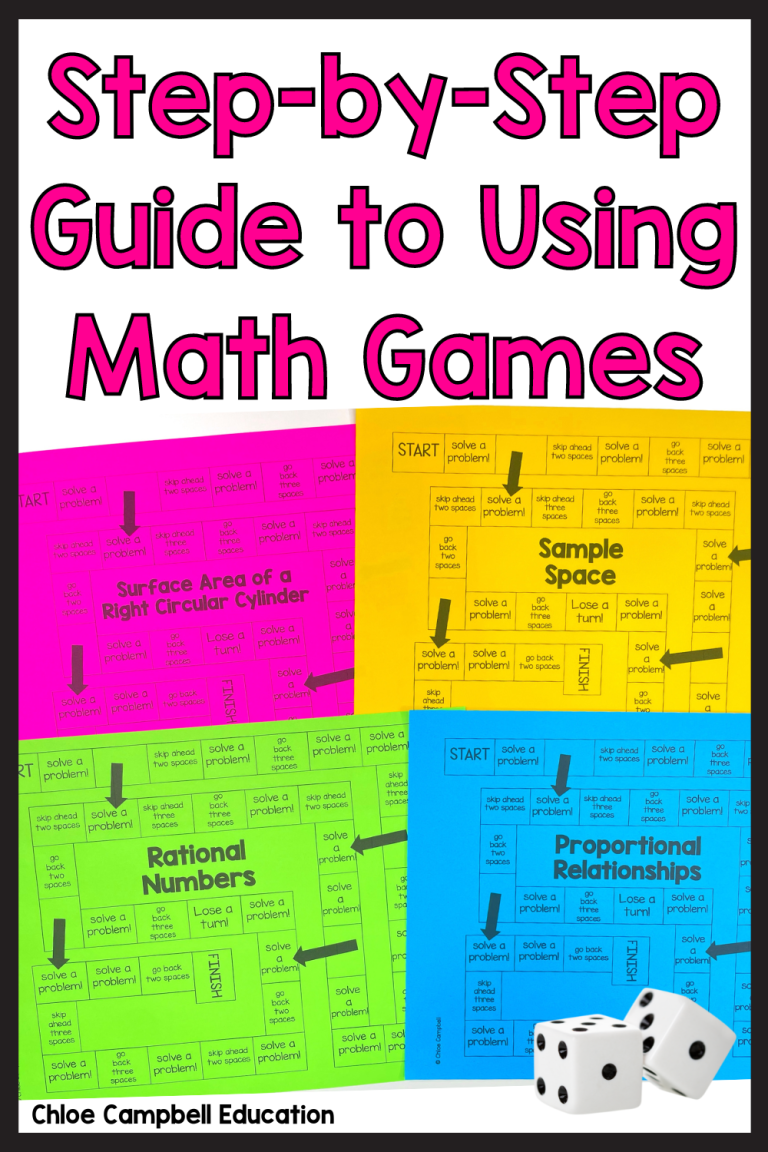7 Integer Games for 7th Graders in Middle School Math
Teaching 7th graders about integers can be quite the challenge. Whether it’s getting them to understand the concept of negative numbers or ensuring they can confidently tackle integer multiplication problems, students often need extra practice to fully grasp these concepts. One of the best ways to help them is by incorporating integer games into your lessons. These games not only make learning fun but also provide students with the repetition and reinforcement they need to master integer operations.
I’ve put together seven of my favorite engaging integer games for 7th graders that you can easily implement in your classroom. Each game is designed to help your students build their math skills in a fun and interactive way.

1. Integers Game: Tic-Tac-Know
How to Play: Tic-Tac-Know is a fantastic twist on the classic game of Tic-Tac-Toe, specifically designed to reinforce integer addition and subtraction skills. To play, you’ll need a Tic-Tac-Toe board (you can draw one on the whiteboard or use printable game boards). Divide your class into pairs or small groups. Each square on the board corresponds to an integer problem that students must solve before they can place their X or O on the board. The problems can range from simple integer addition to more complex subtraction problems.
Pro Tip: Use a variety of difficulty levels to cater to different skill levels within your classroom. For example, some squares might involve basic integer addition, while others could involve subtracting integers with different signs.
2. Positive and Negative Integers Game: Writing Integers on a Number Line
How to Play: This game is an excellent way to help students practice placing integers on a number line. Start by drawing a large number line on your classroom floor using masking tape or by projecting one onto a whiteboard. Hand out cards with different integers (both positive and negative) to your students. One by one, students will place their cards on the correct spot on the number line. For each correct placement, they earn points.
Pro Tip: To increase the challenge, include some rational numbers or have students explain the reasoning behind their placement. This game not only reinforces integer placement but also helps students visualize the relationship between different integers.
This Game is Made For You in Game Board Form! Grab it Here: Positive and Negative Integers Game: Writing Integers on a Number Line
3. Comparing and Ordering Integers Activity
How to Play: This activity is perfect for helping students practice comparing and ordering integers. Begin by creating or printing a set of integer cards with a mix of positive and negative numbers. Divide students into small groups and give each group a set of cards. Their task is to arrange the cards in order from least to greatest (or greatest to least, depending on the instructions). Once they have arranged the integers, they must explain their reasoning, focusing on concepts like absolute value and the placement of negative signs.
Pro Tip: Turn this into a timed challenge to increase the excitement. You could also incorporate different rounds where students first compare integers and then move on to ordering a larger set of numbers.
This Game is Made For You in Game Board Form! Grab it Here: Comparing and Ordering Integers Activity

4. Integer War Card Game
How to Play: Integer War is a simple yet effective game that helps students practice integer addition and subtraction. To play, you’ll need a deck of cards where each card is assigned an integer value (e.g., red cards could be negative, black cards positive). Students play in pairs and flip over two cards at a time. They must add or subtract the integers (depending on the round’s rules) and compare their results. The student with the higher (or lower, depending on the rules) result wins that round and takes the cards. The game continues until one player has all the cards or for a set number of rounds.
Pro Tip: Introduce a twist by adding special cards that require students to solve more complex problems or justify their answers before claiming victory for that round. This adds a layer of critical thinking and deeper understanding of integer operations.
5. Laws of Exponents Game: Integer Exponent Rules
How to Play: This game is designed to help students master the rules of integer exponents, which is crucial as they prepare for 8th-grade math. Begin by introducing or reviewing the laws of exponents with your students. Then, divide the class into small groups and give each group a set of exponent problem cards. Students must solve the problems to move forward in the game. Each correct answer allows the group to move their game piece on a board (which you can create or project). The first group to reach the finish line wins.
Pro Tip: To make the game more engaging, introduce obstacles or challenges on the board where students have to answer bonus questions or solve more difficult exponent problems to proceed. This keeps the game dynamic and helps reinforce the integer exponent rules.
This Game is Made For You in Game Board Form! Grab it Here: Laws of Exponents Game: Integer Exponent Rules

6. Graphing on a Coordinate Plane Game
How to Play: This game is ideal for helping students understand how integers work on a coordinate plane. Begin by reviewing the basics of plotting points on a coordinate plane. Then, give students a set of coordinates that they must correctly plot on a large coordinate plane drawn on the floor or displayed on the board. Each correct plot earns them a point or allows them to move forward in a game (such as a race to reach a certain destination on the plane).
Pro Tip: To add variety, create different stations around the room where students must plot points and solve related integer problems before moving to the next station. This adds movement and variety to the activity, making it more engaging for middle school students.
This Game is Made For You in Game Board Form! Grab it Here: Graphing on a Coordinate Plane Game

7. Integer Four in a Row
How to Play: Integer Four in a Row is a game where students must solve integer multiplication or division problems to place their markers on the board. The goal is to get four markers in a row (horizontally, vertically, or diagonally). To play, prepare a game board with various integer problems, or use a Connect Four game. Students work in pairs or small groups and take turns solving problems. If they solve a problem correctly, they place their marker on the corresponding space.
Pro Tip: To increase engagement, allow students to “block” their opponents by solving a problem in the same row or column, adding a strategic element to the game. This makes it not only a test of math skills but also a game of strategy and quick thinking.
Incorporating these integer games for 7th graders into your lesson plans is a fantastic way to make learning integers fun and engaging. Each of these games offers a unique way to practice and reinforce essential integer operations, from basic addition and subtraction to more complex concepts like exponents and graphing. Whether you’re preparing students for a test, reviewing concepts, or just looking for a fun way to break up the routine, these games are a great addition to your middle school math classroom.
Try them out, and you’ll see your students’ understanding and confidence in working with integers grow exponentially.

Want to save this post for later? Click the image above to save the pin to your favorite Pinterest board!







